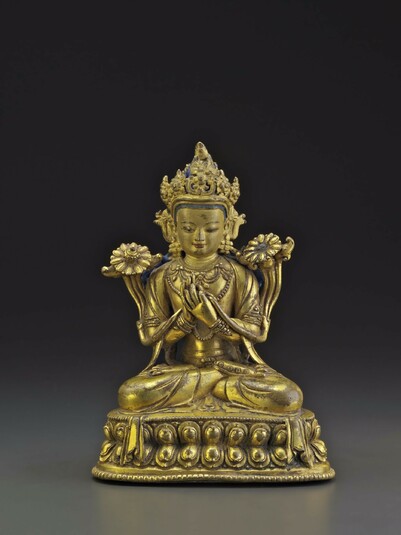
Item: Deity - (Unidentified)
| Origin Location | Tibet |
|---|---|
| Date Range | 1600 - 1699 |
| Lineages | Buddhist |
| Material | Metal |
| Collection | John & Karina Stewart |
Classification: Deity
Deity - Unidentified.
The figure is male and peaceful in appearance with one face and two hands, seated upright in vajra posture. He wears the jewelry and garments typical of a peaceful deity. The two hands are held at the heart in the Dharma teaching gesture. Between the two hands are the stems of two flowers that extend to the sides and upward blossoming at the level of the ears.
There are no readily identifiable or obvious attributes that indicate the identity of the figure. The two flower blossoms held in the hands are a little unusual. The blossom on the proper right side appears intact and not broken in any way. The flower on the left side of the figure appears as though it might possibly have had an attribute of some kind attached at the center of the flower where it appears discoloured and dark.
If this were a depiction of Lokeshvara then he would or should typically have Amitabha Buddha on the crown of the head and a deerskin across the left shoulder.
The figure quite possibly could be a form of Manjushri and the left hand flower could have supported a book, or a book and a sword, which have been broken and lost over time. However if Manjushri is depicted with a sword and a book on a single flower then there typically will not be a second flower held on the right side - just the single flower supporting the two attributes on his left.
The same reasoning for including or excluding applied to Manjushri would also apply for a peaceful form of Vajrapani.
Vairochana Buddha appears either with the hands in the Dharma teaching gesture, the bodhigarbha gesture or with the hands placed in the lap in a meditation gesture. If the hands of Vairochana are placed in the teaching gesture at the heart they would not be holding any attribute but simply perform the gesture of teaching. Likewise, all of the other Buddhas can be ruled out in the same way. The gesture of teaching doesn't conform and the unexplained two flower blossoms do not conform to the iconography of Akshobhya, Amitabha, Ratnasambhava or Amoghasiddhi.
What about Maitreya? Well this might be the most likely suggestion. The flower on the left side might have supported a water flask which has now become lost. Maitreya typically has the hands in the teaching gesture. he also has three common attributes, a wheel, a stupa and a water flask. The wheel is usually placed on a flower on this right side. The stupa often appears on the crown of the head. The water flask is usually placed on the flower at the left side. A fourth attribute which is sometimes seen on figures of Maitreya is the deerskin over the left shoulder. This is an attribute also shared only with Lokeshvara.
If there was an attribute on the flower on the left side of the figure then it is very possible, and possibly most likely, that the image is of Maitreya.
If there was no attribute on the flower on the left side of the figure then it becomes very difficult to say who the figure is trying to represent and the identity remains a mystery.
Jeff Watt 10-2013
View other items in the Thematic Set: Collection: John & Karina Stewart (Metal Sculpture)
